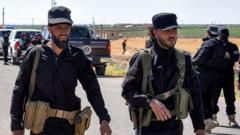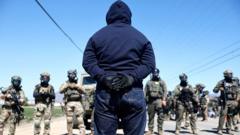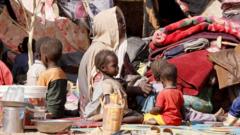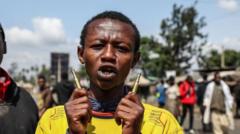As the region of Idlib transitions under the Islamist group Hayat Tahrir al-Sham (HTS), notable changes in administration and community life are apparent, yet apprehensions regarding authoritarian governance linger among residents.
New Beginnings in Idlib: A Glimpse of Potential Rebel Governance in Post-Assad Syria
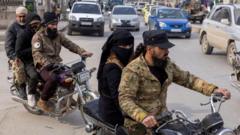
New Beginnings in Idlib: A Glimpse of Potential Rebel Governance in Post-Assad Syria
Idlib, under the control of HTS, exhibits a mix of revitalization and authoritarian rule following the fall of Assad.
Idlib, once a battleground of the Syrian civil war, now stands as a symbol of potential transformation under the control of the Islamist group Hayat Tahrir al-Sham (HTS). Following a decisive offensive that toppled Bashar al-Assad's oppressive regime, HTS has emerged as a key power broker in the region, seeking to establish governance models to extend beyond Idlib itself.
The remnants of previous conflicts are evident in Idlib’s landscape, with trenches and abandoned military structures serving as a stark reminder of its troubled past. However, today's Idlib is bustling with newly opened shops, renovated homes, and functional infrastructure, showcasing a level of stability unseen during the war years. Yet, beneath the surface improvements lies a complex reality marked by governance challenges.
With a population of approximately 4.5 million, the region has witnessed HTS's efforts to reshape its image from a jihadist alignment to one espousing nationalistic ideals. Despite its rebranding, the group faces international condemnation as a terrorist organization by countries including the United States and Turkey.
Dr. Hamza Almoraweh, a local physician, notes the significant developments Idlib has undergone since HTS's rise to power. Medical facilities have improved, and public services, such as water and electricity, are managed through funds generated from local businesses and taxes. "Idlib has a lot of things that it didn't have under the Assad regime," he reflects.
As HTS strives for international recognition and attempts to engage with the citizenry, some social restrictions have eased, such as previous bans on music and strict dress codes for women. Activist Fuad Sayedissa, who recently returned to Idlib after a decade, acknowledges the gradual shifts in governance. "It's not a full democracy, but there's freedom," he asserts.
Yet, there is an undercurrent of dissent among residents as protests against HTS’s authoritarian measures have occurred. Critics caution that the group's consolidating power—often through the intimidation of rivals—could replicate the oppressive governance they sought to escape from under Assad.
In nearby Quniyah, a predominantly Christian community, there are mixed sentiments about the new leadership. Friar Fadi Azar acknowledges the newfound freedoms under HTS compared to prior years but questions the authenticity of these changes. "What can we do? We have no other option," he admits, indicating a complicated balance between hope and skepticism.
As the post-Assad era unfolds, the people of Idlib navigate a path filled with potential but fraught with uncertainty regarding HTS's long-term intentions. While many celebrate their newfound freedoms, a collective caution remains—one reinforced by the lessons of Syria’s harrowing past. "If they act as dictators," warns Sayedissa, "the people are ready to say no."
The remnants of previous conflicts are evident in Idlib’s landscape, with trenches and abandoned military structures serving as a stark reminder of its troubled past. However, today's Idlib is bustling with newly opened shops, renovated homes, and functional infrastructure, showcasing a level of stability unseen during the war years. Yet, beneath the surface improvements lies a complex reality marked by governance challenges.
With a population of approximately 4.5 million, the region has witnessed HTS's efforts to reshape its image from a jihadist alignment to one espousing nationalistic ideals. Despite its rebranding, the group faces international condemnation as a terrorist organization by countries including the United States and Turkey.
Dr. Hamza Almoraweh, a local physician, notes the significant developments Idlib has undergone since HTS's rise to power. Medical facilities have improved, and public services, such as water and electricity, are managed through funds generated from local businesses and taxes. "Idlib has a lot of things that it didn't have under the Assad regime," he reflects.
As HTS strives for international recognition and attempts to engage with the citizenry, some social restrictions have eased, such as previous bans on music and strict dress codes for women. Activist Fuad Sayedissa, who recently returned to Idlib after a decade, acknowledges the gradual shifts in governance. "It's not a full democracy, but there's freedom," he asserts.
Yet, there is an undercurrent of dissent among residents as protests against HTS’s authoritarian measures have occurred. Critics caution that the group's consolidating power—often through the intimidation of rivals—could replicate the oppressive governance they sought to escape from under Assad.
In nearby Quniyah, a predominantly Christian community, there are mixed sentiments about the new leadership. Friar Fadi Azar acknowledges the newfound freedoms under HTS compared to prior years but questions the authenticity of these changes. "What can we do? We have no other option," he admits, indicating a complicated balance between hope and skepticism.
As the post-Assad era unfolds, the people of Idlib navigate a path filled with potential but fraught with uncertainty regarding HTS's long-term intentions. While many celebrate their newfound freedoms, a collective caution remains—one reinforced by the lessons of Syria’s harrowing past. "If they act as dictators," warns Sayedissa, "the people are ready to say no."



